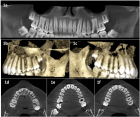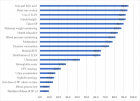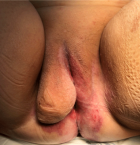Abstract
Research Article
Determinants of health seeking behaviour of women with obstetric fistula in south- south and south east, Nigeria: A review of the impact of availability and quality of health care services through a cross-sectional study
Peters Grace E*, Ononokpono Dorathy N, Willson Nsikanabasi U, Oko Nnabuike I and Peters EJ
Published: 04 May, 2021 | Volume 4 - Issue 2 | Pages: 060-065
Background: Obstetric fistula is a condition that results from obstructed labour, which occurs when the baby cannot pass through the mother’s birth canal because it either does not come head first or is too large for her pelvis. Prompt medical intervention, often including Caesarean section, permits a safe delivery for both mother and child. Despite this possibility, yearly, thousands of women across the country receive no such aid and their labour is a futile agony lasting between three and five days, with uterine contractions constantly forcing the baby, usually head first, against the organs of the pelvic and unyielding pelvic bone resulting in Vesico Vaginal Fistula (VVF). The main thrust of this study was to examine how health system factors affect health seeking behaviour of women with obstetric fistula in Akwa Ibom and Ebonyi States, Nigeria.
Methods: Qualitative and descriptive research approaches were adopted for the study and a total sample of two hundred and sixteen (216) respondents comprising of one hundred and fifty (150) post fistula repair operative patients and sixty six (66) health workers were purposively selected using simple random techniques. The data were analyzed using thematic analysis and tables of frequency.
Results: The respondents views showed that availability of treatment centre and quality of health care services influenced health seeking behaviour of women with obstetric fistula in Nigeria.
Conclusion: The study indicated that health seeking behaviour of women with obstetric fistula is a major challenge in Nigeria. Establishment and proper equipment of obstetric fistula treatment centres as well as subsidization of the cost of treatment to allow women with this health problem to access health care services are strongly recommended. Therefore, government at all level and non-governmental organizations need to educate the women and create awareness on the causes and dangers of VVF.
Read Full Article HTML DOI: 10.29328/journal.cjog.1001088 Cite this Article Read Full Article PDF
Keywords:
Determinants; Availability of treatment centre and quality of health care services and obstetric fistula
References
- Ololade O. This marriage will kill me. The Nation. 2014. http://thenationonline.net/new
- Kabir M. Medico social problems of patients with vesico vaginal fistula in Murtala Mohamed Specialist Hospital in Kano. Bioline Int Ann African Med. 2004; 2: 54-57.
- Abokaiagana A. Experiences of women with obstetric fistula in the Bawku East District of the Upper East Region College of Health Sciences. School Nur. 2010; 67-110.
- Adebayo T. VVF prevalence soars in Nigeria. Newswatch Times. 2015. http://mydailynewswatchtimesng.com
- Leo R. Nigeria: Nigeria has highest prevalence of obstetric fistula. 2016. allafrica.com
- Nabob O. Ebonyi tops in VVF cases – USAID. Daily Trust Newspaper. 2017. dailytrust.com.ng
- Eyo UE, Udobang C. Influence of maternal variables on the occurrence of vesico vaginal fistula in Uyo Local Government Area of Akwa Ibom State, Nigeria. Research on Humanities and Social Sciences. 2014; 4: 164-168.
- Umeha C. FG urged to increase facilities to tackle obstetric fistula. Daily Independent. 2016. www.dailyindependentnig.com
- Bill G. Sample size formulas. 2021. williamgodden.com
- Ajaegbu OO. Perceived challenges of using maternal health care services in Nigeria. Arts Soc Sci J. 2013; 7: 54 - 65.
- Federal Ministry of Health. National Strategic framework for the elimination of fistula, 2012-2017. Federal Ministry of Health, Abuja. 2012; 98-54.
- Gbola F. Vesico-vagina fistula and psychosocial well-being of women in Nigeria. 2007; www.emedicine.com/medtopic3321.htm
- Ibekwe PC. Health care problems in developing countries. Med Practition Rev. 2010; 1: 9–11.
- Edeh SB. 12,000 women develop VVF every year in Nigeria. Vanguard. 2015. http://www.vanguardngr.com
- Adesegun F. Maternal mortality situation and determinants in Nigeria. Federal Ministry of Health. Abuja. 2004.
- Sina OJ, Jegede LI, Ibikunle AM. Socio-economic status and utilization of healthcare facilities in rural Ekiti, Nigeria. Standard Res J. 2014; 2: 001-043.
- Federal Ministry of Health. National strategic framework for the elimination of obstetric fistula in Nigeria (2011-2005). Abuja. 2012; 76-99.
- \Warren C, Agbonkhese R, Ishaku S. Formative research on assessing barriers to fistula care and treatment in Nigeria. USAID, Fistula Care Plus, Engerder Health and Population Council. 2016.
Similar Articles
-
Determinants of women’s perceived satisfaction on Antenatal care in urban Ghana: A cross-sectional studyAkowuah Jones Asafo*,Danquah Benedicta Adoma. Determinants of women’s perceived satisfaction on Antenatal care in urban Ghana: A cross-sectional study. . 2019 doi: 10.29328/journal.cjog.1001022; 2: 038-053
-
Determinants of neonatal near miss among neonates admitted to Ambo University Referral Hospital and Ambo General Hospital, Ethiopia, 2019Ephrem Yohannes*,Nega Assefa,Yadeta Dessie. Determinants of neonatal near miss among neonates admitted to Ambo University Referral Hospital and Ambo General Hospital, Ethiopia, 2019. . 2020 doi: 10.29328/journal.cjog.1001050; 3: 046-053
-
Determinants of health seeking behaviour of women with obstetric fistula in south- south and south east, Nigeria: A review of the impact of availability and quality of health care services through a cross-sectional studyPeters Grace E*,Ononokpono Dorathy N,Willson Nsikanabasi U,Oko Nnabuike I,Peters EJ. Determinants of health seeking behaviour of women with obstetric fistula in south- south and south east, Nigeria: A review of the impact of availability and quality of health care services through a cross-sectional study. . 2021 doi: 10.29328/journal.cjog.1001088; 4: 060-065
-
Comparative analysis of cesarean section using the Robson's Ten-Group Classification System (RTCGS) in private and public hospitals, Addis Ababa, EthiopiaEndalkachew Mekonnen Assefa*,Adem Janbo,Yirgu Ghiwot. Comparative analysis of cesarean section using the Robson's Ten-Group Classification System (RTCGS) in private and public hospitals, Addis Ababa, Ethiopia. . 2021 doi: 10.29328/journal.cjog.1001093; 4: 081-091
-
Quality of Antenatal Care and its Determinants in the Urban-Rural Environment of Kamina, Democratic Republic of the CongoIgnace Bwana Kangulu*, Jules Ngwe Thaba Moyambe, Michel Kabamba Nzaji, Ange Assumani Kibibi, Alain Mbayo Kazadi, Elie Kilolo Ngoy Umba, John Ngoy Lumbule, Eric Kiwele Zongwe, Xavier Kinenkinda Kalume, Albert Mwembo Tambwe A'Nkoy, Jean Baptiste Kakoma. Quality of Antenatal Care and its Determinants in the Urban-Rural Environment of Kamina, Democratic Republic of the Congo. . 2023 doi: 10.29328/journal.cjog.1001136; 6: 101-107
Recently Viewed
-
The efficacy of complex Decongestive Physiotherapy in patients with Bilateral Primary Lower Extremity Lymphedema and Untreatable multiple health conditions: A Case ReportHümeyra Kiloatar PT*. The efficacy of complex Decongestive Physiotherapy in patients with Bilateral Primary Lower Extremity Lymphedema and Untreatable multiple health conditions: A Case Report. J Nov Physiother Rehabil. 2017: doi: 10.29328/journal.jnpr.1001011; 1: 093-098
-
Cystoid Macular Oedema Secondary to Bimatoprost in a Patient with Primary Open Angle GlaucomaKonstantinos Kyratzoglou*,Katie Morton. Cystoid Macular Oedema Secondary to Bimatoprost in a Patient with Primary Open Angle Glaucoma. Int J Clin Exp Ophthalmol. 2025: doi: 10.29328/journal.ijceo.1001059; 9: 001-003
-
Metastatic Brain Melanoma: A Rare Case with Review of LiteratureNeha Singh,Gaurav Raj,Akshay Kumar,Deepak Kumar Singh,Shivansh Dixit,Kaustubh Gupta*. Metastatic Brain Melanoma: A Rare Case with Review of Literature. J Radiol Oncol. 2025: doi: ; 9: 050-053
-
Depression as a civilization-deformed adaptation and defence mechanismBohdan Wasilewski*,Olha Yourtsenyuk,Eugene Egan. Depression as a civilization-deformed adaptation and defence mechanism. Insights Depress Anxiety. 2020: doi: 10.29328/journal.ida.1001013; 4: 008-011
-
Drinking-water Quality Assessment in Selective Schools from the Mount LebanonWalaa Diab, Mona Farhat, Marwa Rammal, Chaden Moussa Haidar*, Ali Yaacoub, Alaa Hamzeh. Drinking-water Quality Assessment in Selective Schools from the Mount Lebanon. Ann Civil Environ Eng. 2024: doi: 10.29328/journal.acee.1001061; 8: 018-024
Most Viewed
-
Evaluation of Biostimulants Based on Recovered Protein Hydrolysates from Animal By-products as Plant Growth EnhancersH Pérez-Aguilar*, M Lacruz-Asaro, F Arán-Ais. Evaluation of Biostimulants Based on Recovered Protein Hydrolysates from Animal By-products as Plant Growth Enhancers. J Plant Sci Phytopathol. 2023 doi: 10.29328/journal.jpsp.1001104; 7: 042-047
-
Sinonasal Myxoma Extending into the Orbit in a 4-Year Old: A Case PresentationJulian A Purrinos*, Ramzi Younis. Sinonasal Myxoma Extending into the Orbit in a 4-Year Old: A Case Presentation. Arch Case Rep. 2024 doi: 10.29328/journal.acr.1001099; 8: 075-077
-
Feasibility study of magnetic sensing for detecting single-neuron action potentialsDenis Tonini,Kai Wu,Renata Saha,Jian-Ping Wang*. Feasibility study of magnetic sensing for detecting single-neuron action potentials. Ann Biomed Sci Eng. 2022 doi: 10.29328/journal.abse.1001018; 6: 019-029
-
Pediatric Dysgerminoma: Unveiling a Rare Ovarian TumorFaten Limaiem*, Khalil Saffar, Ahmed Halouani. Pediatric Dysgerminoma: Unveiling a Rare Ovarian Tumor. Arch Case Rep. 2024 doi: 10.29328/journal.acr.1001087; 8: 010-013
-
Physical activity can change the physiological and psychological circumstances during COVID-19 pandemic: A narrative reviewKhashayar Maroufi*. Physical activity can change the physiological and psychological circumstances during COVID-19 pandemic: A narrative review. J Sports Med Ther. 2021 doi: 10.29328/journal.jsmt.1001051; 6: 001-007

HSPI: We're glad you're here. Please click "create a new Query" if you are a new visitor to our website and need further information from us.
If you are already a member of our network and need to keep track of any developments regarding a question you have already submitted, click "take me to my Query."
















































































































































